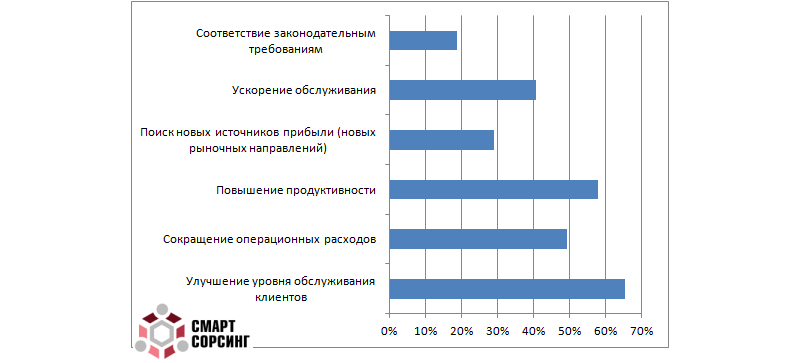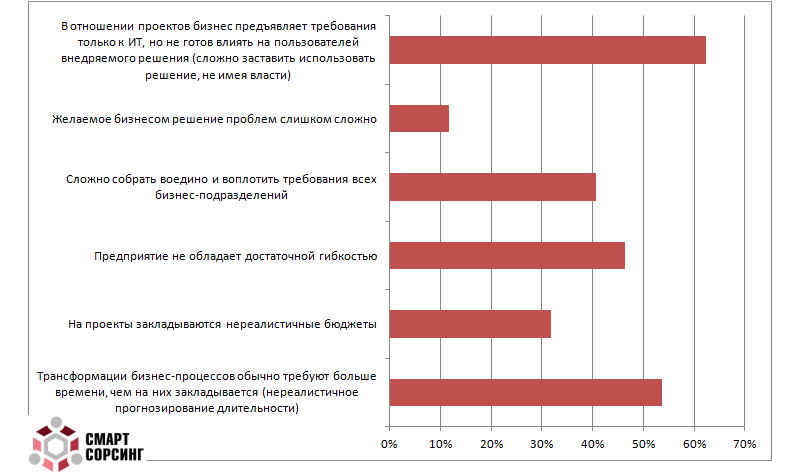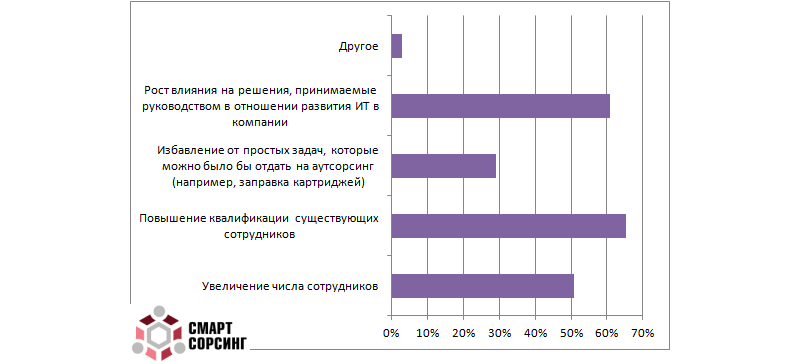Mutual misunderstanding of IT and business does not allow to feel the effect of the implemented solutions.
As part of the IT executives community SmartSourcing, we conducted a survey on the subtleties of interaction between IT and business in the implementation of infrastructure projects. About 150 people took part in the survey. Judging by the answers, the depth of mutual misunderstanding between IT and business in Russia is much greater than in the West. However, the topics of the relationship between IT and business in the Russian IT communities in general are not encouraging at all. Business often has the same cool attitude towards IT. It is clear that no company can operate today without IT systems, but “it’s good if the company sustains the introduction of any three-letter IT bauble” , as Dmitry Potapenko, one of the most prominent representatives, said at one of the IT conferences. Russian business. Our survey reveals various technical and organizational problems that can and should be dealt with. And it is better to do it at an early stage, until the situation finally comes to a standstill.

There are always several points of view on the same IT solution. It is usually accepted to contrast the view of the marketing person selling this decision with the business buying it. But, in my opinion, marketing has long been speaking the same language with business, otherwise marketers would not have the influence that they have in the modern world. But the heads of IT departments, as well as representatives of many IT companies are more interested in their technological toys than the tasks of the enterprises with which they work. As a result, there is a clear conflict of interest between the business and the IT department, which eventually turns into failed IT projects, non-performing IT products and other “joys”.
')
Western analysts have been writing about the reasons for this contradiction for quite some time. The main culprit in this case is the generally accepted scheme of work, when the decision to acquire a new “super tool” is taken by the business leader from some considerations of its own, and the IT department is forced to work with the fact that they were “lowered from above” . The situation when IT representatives do not have a voice when choosing products to be introduced does not at all contribute to exact observance of the established deadlines and budgets, because the management doesn’t have to look for ways to “make friends” with the old ones that are not fully implemented. And, of course, the problem builds up like a snowball: each not very successful implementation undermines the already limited trust in the IT department, i.e. the gap between IT and business is only widening ( it should be noted that there are similar problems of mutual understanding in communication with outsourcers , so it cannot be said that internal IT services are highlighted in something here). Interestingly, one of the “markers” of the problem is considered to be the rapid development of cloud solutions that ordinary employees of the enterprise and even managers begin to use to bypass their own IT service , since they consider the latter to be inconsistent with modern requirements (obviously, making this conclusion based on the results of the latter projects).
Most analysts on this issue come to us from foreign publications. We decided to find out how deep the abyss of misunderstanding between IT and business in the Russian context. To do this, we conducted a small survey within the IT community SmartSourcing . In our questions, we did not specify whether we are talking about an internal IT department or an IT outsourcer, to whom some infrastructure projects have been given. Our focus was precisely on relationships. It should be immediately noted that the interest of community members in this survey was minimal (about 150 people answered questions) and significantly lower than the usual activity of community members in our surveys. Those. a similar theme for many representatives of the IT community simply does not exist.
Since the survey was conducted within the IT community, we only managed to look at the problem from one side. All responding participants somehow related to the IT business (being either a manager or an employee of an IT department or enterprise). But even such a “one-sided” study provides a general idea of the current situation.
The main result is the total dissatisfaction of specialists with the existing IT infrastructure. According to the majority of respondents (57%), the infrastructure of enterprises today does not meet their real needs.

(The main needs of the enterprise from the point of view of IT professionals who participated in the survey. Under the terms of the survey, it was possible to choose several answers)
To eliminate inconsistencies, i.e. turning the IT infrastructure into a really working component of a business; various IT projects are initiated. But the problem is that each subsequent project does not really bring closer a state of mutual understanding between IT and business leaders. The overwhelming majority of respondents (73%) believe that businesses are not fully satisfied with the results of these projects. True, 54% believe that only implementation deadlines cause dissatisfaction, but 19% are confident that, in the opinion of business, the IT development course at the enterprise is not right.

(The main reasons for dissatisfaction with the business course and the pace of development of the IT infrastructure - according to IT specialists surveyed. According to the survey conditions, one could choose several answers)
The main problem is that the situation is constantly aggravated. On the one hand, pressure on IT from business is increasing (56% of the respondents reported this to us). On the other hand, the time allotted for each project is reduced. More than a third of our survey participants (34%) noted that over the past year or two, the implementation deadlines for key projects have become shorter.
Business can be understood: it exists in a mode where the rapid automation of individual processes can provide a serious competitive advantage (especially if competitors are simultaneously engaged in the same improvements — in this case, it is impossible to keep up with the “locomotive” of modernization and introduction of new tools). However, there is a completely viable theory that it is impossible to accelerate IT implementation projects indefinitely. Regardless of how much free money and man-hours to invest in a project, sooner or later, the specified rate of implementation will begin to conflict with the limited speed of evolution of the human mentality . Failure to understand this fact in business is another fertile field for growing dissatisfaction with the IT department.
Unfortunately, today, for the most part, IT can only make arguments in its defense on the basis of unsuccessful (or not completed in time) implementations, but not correct the process, in accordance with its own ideas about the possible. According to our survey, the influence of the IT department on making key decisions regarding purchases or even the entire course of infrastructure development remains low (65% of respondents favored this). 61% believe that one of the main transformations needed by the IT department is just increasing its role in making management decisions.

(A complete list of the transformations required by the IT department in the opinion of the interviewed specialists. According to the survey conditions it was possible to choose several answer options)
Thus, there is not so much a technological, as an organizational misunderstanding. We can not say that now is the time to deal with it. To tell the truth, the survey clearly shows that “that very” time has already been lost. But in an environment where the authority of the IT department is no longer up to the mark under the pressure of consumerisation , it is critical to take steps to “reconcile” the business and IT.

There are always several points of view on the same IT solution. It is usually accepted to contrast the view of the marketing person selling this decision with the business buying it. But, in my opinion, marketing has long been speaking the same language with business, otherwise marketers would not have the influence that they have in the modern world. But the heads of IT departments, as well as representatives of many IT companies are more interested in their technological toys than the tasks of the enterprises with which they work. As a result, there is a clear conflict of interest between the business and the IT department, which eventually turns into failed IT projects, non-performing IT products and other “joys”.
')
Western analysts have been writing about the reasons for this contradiction for quite some time. The main culprit in this case is the generally accepted scheme of work, when the decision to acquire a new “super tool” is taken by the business leader from some considerations of its own, and the IT department is forced to work with the fact that they were “lowered from above” . The situation when IT representatives do not have a voice when choosing products to be introduced does not at all contribute to exact observance of the established deadlines and budgets, because the management doesn’t have to look for ways to “make friends” with the old ones that are not fully implemented. And, of course, the problem builds up like a snowball: each not very successful implementation undermines the already limited trust in the IT department, i.e. the gap between IT and business is only widening ( it should be noted that there are similar problems of mutual understanding in communication with outsourcers , so it cannot be said that internal IT services are highlighted in something here). Interestingly, one of the “markers” of the problem is considered to be the rapid development of cloud solutions that ordinary employees of the enterprise and even managers begin to use to bypass their own IT service , since they consider the latter to be inconsistent with modern requirements (obviously, making this conclusion based on the results of the latter projects).
Most analysts on this issue come to us from foreign publications. We decided to find out how deep the abyss of misunderstanding between IT and business in the Russian context. To do this, we conducted a small survey within the IT community SmartSourcing . In our questions, we did not specify whether we are talking about an internal IT department or an IT outsourcer, to whom some infrastructure projects have been given. Our focus was precisely on relationships. It should be immediately noted that the interest of community members in this survey was minimal (about 150 people answered questions) and significantly lower than the usual activity of community members in our surveys. Those. a similar theme for many representatives of the IT community simply does not exist.
Since the survey was conducted within the IT community, we only managed to look at the problem from one side. All responding participants somehow related to the IT business (being either a manager or an employee of an IT department or enterprise). But even such a “one-sided” study provides a general idea of the current situation.
The main result is the total dissatisfaction of specialists with the existing IT infrastructure. According to the majority of respondents (57%), the infrastructure of enterprises today does not meet their real needs.

(The main needs of the enterprise from the point of view of IT professionals who participated in the survey. Under the terms of the survey, it was possible to choose several answers)
To eliminate inconsistencies, i.e. turning the IT infrastructure into a really working component of a business; various IT projects are initiated. But the problem is that each subsequent project does not really bring closer a state of mutual understanding between IT and business leaders. The overwhelming majority of respondents (73%) believe that businesses are not fully satisfied with the results of these projects. True, 54% believe that only implementation deadlines cause dissatisfaction, but 19% are confident that, in the opinion of business, the IT development course at the enterprise is not right.

(The main reasons for dissatisfaction with the business course and the pace of development of the IT infrastructure - according to IT specialists surveyed. According to the survey conditions, one could choose several answers)
The main problem is that the situation is constantly aggravated. On the one hand, pressure on IT from business is increasing (56% of the respondents reported this to us). On the other hand, the time allotted for each project is reduced. More than a third of our survey participants (34%) noted that over the past year or two, the implementation deadlines for key projects have become shorter.
Business can be understood: it exists in a mode where the rapid automation of individual processes can provide a serious competitive advantage (especially if competitors are simultaneously engaged in the same improvements — in this case, it is impossible to keep up with the “locomotive” of modernization and introduction of new tools). However, there is a completely viable theory that it is impossible to accelerate IT implementation projects indefinitely. Regardless of how much free money and man-hours to invest in a project, sooner or later, the specified rate of implementation will begin to conflict with the limited speed of evolution of the human mentality . Failure to understand this fact in business is another fertile field for growing dissatisfaction with the IT department.
Unfortunately, today, for the most part, IT can only make arguments in its defense on the basis of unsuccessful (or not completed in time) implementations, but not correct the process, in accordance with its own ideas about the possible. According to our survey, the influence of the IT department on making key decisions regarding purchases or even the entire course of infrastructure development remains low (65% of respondents favored this). 61% believe that one of the main transformations needed by the IT department is just increasing its role in making management decisions.

(A complete list of the transformations required by the IT department in the opinion of the interviewed specialists. According to the survey conditions it was possible to choose several answer options)
Thus, there is not so much a technological, as an organizational misunderstanding. We can not say that now is the time to deal with it. To tell the truth, the survey clearly shows that “that very” time has already been lost. But in an environment where the authority of the IT department is no longer up to the mark under the pressure of consumerisation , it is critical to take steps to “reconcile” the business and IT.
Source: https://habr.com/ru/post/206700/
All Articles